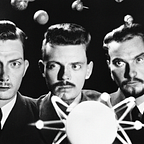Cyber-Ecology
Environmental Circuits
For Christmas, I got an Arduino Sparkfun Inventor Kit:
Since then, I’ve spent many hours feverishly plugging and unplugging jumper cables and components into and from a breadboard and Sparkfun’s own RedBoard Arduino open-source micro-controller.
Fritzing
Fritzing is another open-source app which lets you create graphical (above) and schematic representations (below) of your Arduino circuits:
Experimenting at a combined hardware/software level like this is really fun and educational af. I understand electronics at a way more fundamental level than I did before these practical experiments — and most importantly: what happens when current flows.
Energy flows
I can’t help, while doing this, but to personify all the different little components you plug into a board to get it to do something. This one’s a human (LED), this one’s a dog following it around eating it’s food (resistor). It’s a pretty short hop over from attributing quasi-animist attributes onto electrical components over to looking ecology as a transfer of energy flowing through a network of living actors and non-living materials.
Unsurprisingly, better minds than mine tracks down in this fertile territory as far back as the 1960's— most famouse Howard T. Odum and his Energy Systems Language ecological modeling notation, or “Energese.”
Complex Systems
And the symbols applied to describe an ecologic system:
Odum treated ecosystems as thermodynamic systems with sources, stores, flows and sinks of energy, plus producers, consumers, transactions and so forth. This theory enabled Odum and his brother to go so far (among many other academic achievements) as to propose an energy-based valuation of ecosystem services provided by Nature — a fascinating topic all on its own.
Cybernetics
In short, the Odum brothers, “introduced ideas from general systems theory and cybernetics into the field of ecology.”
Here is an interesting exploration of some of these ideas in relation to Ecological Design Modeling and differential equations:
Chicken Coop Dynamics
There’s a famous (to me, anyway) diagram often seen repeated in Permaculture which takes the chicken and uses it as what might be considered a “node” in an energetic ecological network such as this:
I keep six laying hens year round, and made this ESL-style diagram below of the bounded system of my chicken coop as an exploration of this idea of natural circuits:
I’m sure I’m not using the modeling system with the rigor intended by its creators, but it’s interesting regardless to look at the natural processes + my labor which goes into keeping chickens in a coop. What goes into them in terms of food and water flows, and what comes out of them — literally in terms of eggs and shit, etc.
Not depicted above are the workflows linking feed back to other farms, processing and transportation systems and the store where I bought it. Also not depicted are my personal workflows of going out daily to collect the eggs, and once per week change their water and food.
Actor-Network Theory as Ecology
Also also not depicted in my quick diagram above is the nearby garden onto which the finished litter/fertilizer is spread, and which in turn activates its own assemblage or network of linked components — or in the words of Actor-Network theory: other actants.
“Actants denote human and non-human actors, and in a network take the shape that they do by virtue of their relations with one another. It assumes that nothing lies outside the network of relations, and as noted above, suggests that there is no difference in the ability of technology, humans, animals, or other non-humans to act (and that there are only enacted alliances). As soon as an actor engages with an actor-network it too is caught up in the web of relations, and becomes part of the entelechy.” [Actor-Network Theory — Wikipedia]
Anyway, I’ll close this discussion out with a short (28 min) documentary on the Arduino as food for thought:
Living Circuits
Plus an article about a science experiment which I can’t help but think is a bit creepy:
The researchers soaked a garden rose, with its roots and leaves removed, in a solution of PEDOT. Over the course of a couple of days, the polymer was taken up by the plant’s network of xylem and then solidified inside it as a gel. When they peeled away the outer bark and tissue at the bottom of the stem, the researchers could see slender dark wires winding through the rose. […]
The team used the xylem wires to make a transistor — a basic building block of computing and electronics. They tacked gold electrodes and probes along the length of the plant, then connected it to an external resistor and ran a current through it.
In a second experiment, they flushed PEDOT into the rose’s leaves, forcing the polymer into its pores using a basic pressure chamber. When they ran a current across the leaf, they saw its colours changing faintly in response to the voltage.
See also:
